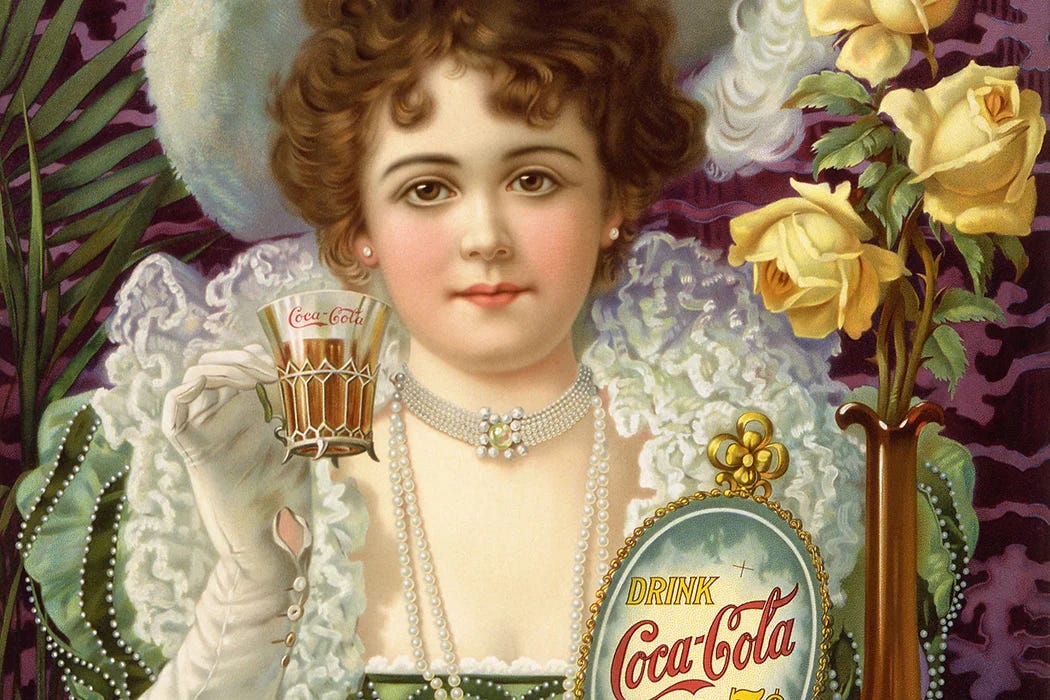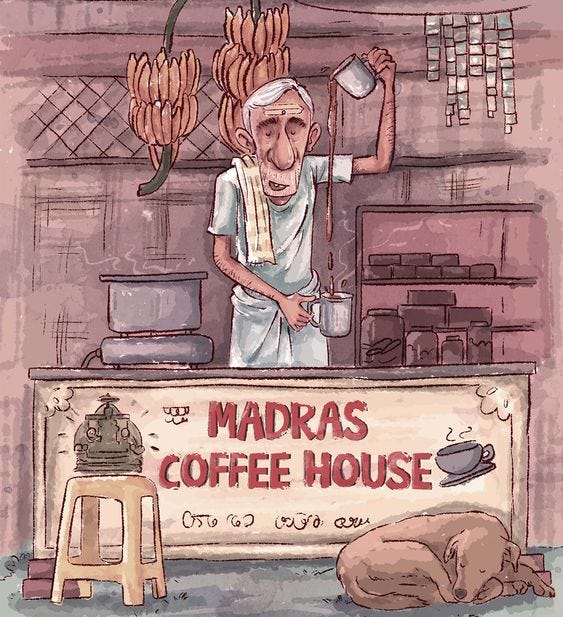🥤Coca Cola’s History with Cocaine
Source: JSTOR
The meeting of Dr. John Stith Pemberton and cocaine was unprecedented. The founder of Coca-Cola suffered a serious injury in 1865 which made him highly dependent on morphine to subdue the pain. The dependency became as such that when he came across cocaine in Atlanta, he was struck - cocaine seemed to resolve his addiction of morphine. Dr. Pemberton quickly declared cocaine a medical miracle, absolutely devoid of any danger and a solution to the middle class' growing disorder of ‘nervousness’. Pemberton started his own Coca Wine in 1884 and targeted it to a select audience of white New South Professionals which became a huge success. He then changed his ingredients, added coca extract and caffeine rich extracts of African Kola nut along with our coke. The drink was a success since it appealed to a large section and it was lovingly nicknamed ‘dope’ which meant a generic term for a pleasurable drug. Soon, Pemberton died as his health had weakened due to two decades of addiction to morphine and cocaine and his business partner, Grigs Candler took over the operations of Coca Cola. Soon, people became interested in the ingredients of Coca Cola. Mind you, up until now, Coca Cola Company hadn’t revealed they used cocaine. Religious and civic leaders started posing Coca cola as a dangerous vice. Candler was in no mood of changing the formula as it could mean losing his patent and his expanding market-share. He kept on promoting it’s ‘refreshing’ and ‘great tasting’ qualities. Coca Cola’s growing popularity made it greatly available to lower class whites and African Americans. A sinister transformation occurred as white society began to view cocaine as a dangerous substance, particularly when associated with African Americans.
Sensationalized news reports and stereotypes of violent, drug-crazed black individuals emerged, fueling fear and prejudice. These distorted perceptions provided a convenient justification for discriminatory policies and practices.
The culmination of this racial hysteria was the passage of the Harrison Narcotics Act of 1914. Ostensibly designed to combat drug abuse, the law disproportionately targeted African Americans. By criminalizing cocaine, the government created a legal framework that allowed for the mass incarceration of black people, perpetuating a cycle of systemic racism. This legislation marked a significant step in the evolution of the War on Drugs, a policy that continues to have a devastating impact on Black communities to this day.
I will be covering the policy of War on Drugs led by the United States federal government in some other issue.
🪴Fritz Haber: The Man who Killed Millions and Saved Billions
In the heart of Germany, in the early 1900s, lived a brilliant scientist named Fritz Haber. Haber was a man of many talents, and his discoveries would have a profound impact on the world. He was a chemist, a physicist, and a philosopher. He was also a man of great ambition and determination.
Haber's most famous discovery was the Haber-Bosch process, a method for synthesizing ammonia from nitrogen and hydrogen. This process revolutionized agriculture, providing a means to produce large-scale fertilizers and dramatically increasing food production. It is estimated that this process sustains approximately half of the world's population today.
For this monumental contribution, Haber was awarded the Nobel Prize in Chemistry in 1918. However, his legacy is deeply marred by his involvement in the development of chemical weapons during World War I. Haber was a German patriot and so he volunteered for military service. He saw a critical need for explosives and redirected his ammonia production facilities towards munitions manufacturing. Haber became a key figure in Germany's chemical weapons program, overseeing the development of chlorine gas, a weapon that caused immense suffering and death.
Haber's contributions to human life and his role in chemical warfare has made him a highly controversial figure. His work on ammonia synthesis is undeniably a cornerstone of modern agriculture and has saved countless lives but his involvement in chemical weapons development is a dark stain on his legacy.
Fun fact: The video also mentions ‘guano’, which is a type of bird poop, was once a valuable commodity due to its high nitrogen content. This nitrogen is crucial for plant growth and was used to improve crop yields It came in shortage when the Peruvian government, the primary exporter of guano, implemented export restrictions and price controls to maximize profits. This further limited the availability of guano to other countries, creating a global shortage and ultimately leading to the development of the the Haber-Bosch process.
🛍️The More the Better Right? Well, Not Really.
Source: Brax.io
The more the better right? Well when it comes to making decisions - not really. Ever wondered why do you see ‘Amazon’s Choice’ or ‘Myntra’s/M’s Choice’ when you look up an article on their website? It is to prevent you from going into a spiral of ‘Over Choice’. Choice overload, or over-choice, is a situation in which a person is faced with too many choices, especially in a retail situation. There are numerous reactions to this issue, including decision fatigue – that is, a worsening ability to make the right decisions. So what should a business do in this case - offer too little? Nope. The phenomenon of single option aversion, shows how consumers are unlikely to pick even an option they like when they have no other alternatives offered to them. People don’t like to be forced, even if they want that something. Picking when only a single option is available prevents them from comparing options. People are convinced that they are making a hasty or ill-informed decision when there is no other choice, even when everything points to be a good choice.
The best no of options can be truly determined by testing the number of choices being made available and creating a buyer persona aka mapping out all the relevant demographic/psycho-graphic etc details and truly understanding your customer. There are also some additional ways to curb decision fatigue like:-
Limit Trade-off Decisions: Place your complimentary/supplementary products closely to each other so that the customer can choose only your brand when caught up b/w features available in yours vs your competitor’s brand. For example, if you’re a toothpaste brand you place your whitening/gum care/breath care products next to each other to limit the choosing of another brand.
Offer Clear Categorization: Customers enjoy using different filters to perfectly match what the are looking for. So, list your product with a variety of relevant tags and features to increase the chance of selection.
Curate & Personalize: Yep, use AI and other means to highly attune your website to individual needs and reduce decision fatigue.
Highlight the best Option: And as mentioned initially, highlight the best option.
✍🏻Poem of the Week:
This is one of my most favorite poem.
📃Quote of the Week:
Always remember - if its possible for other people, it is possible for you.
🎨Art of the Week:
Artist: Nipen Bhuyan
Thank you so much for reading guys! Have a great new week <3
toodles~
PS: Someone once asked me how do I calculate the reading time. I use a website which translates the number of words into time, keeping avg rate as 275 words/min. Hope that clears the doubt.








